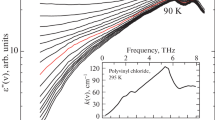Summary
The applicability of the time-temperature superposition principle on the dielectric relaxation phenomena was checked on several kinds of high polymers in the elastic state as well as in glassy state. In case of theα-absorption observed in elastic state, the time-temperature superposition principle is usually applicable at temperatures much higher than the so-called glass transition temperature. On the contrary, in case of theβ-absorption, observed in glassy state, the super-position principle is usually applicable at temperatures much lower than the so-called glass transition temperature. In the semi-crystalline polymers, however, the superposition principle is applicable only on the sample which is annealed enough, because the development of crystallization with increasing temperature leads to the broadening of the shape of the absorption.
The distribution curves of relaxation times in elastic state was calculated on these polymers. As a result, it was made known that the distribution curve of relaxation times of the polymer with good crystallizability is usually broader than that of the polymers with bad crystallizability.
Zusammenfassung
Die Anwendbarkeit des Prinzips der Zeit-Temperatur-Superposition auf dielektrische Relaxationsphänomene wurde an verschiedenen Hochpolymeren im elastischen wie im glasigen Zustand geprüft. Für ihreα-Absorption im elastischen Zustand ist dieses Prinzip gewöhnlich anwendbar bei Temperaturen, wesentlich höher als der Glastransformationspunkt. Für dieβ-Absorption im Glaszustand ist es dagegen anwendbar bei Temperaturen, die niedriger als die Glastransformationstemperatur liegen. In partiell kristallinen Hochpolymeren aber ist es nur anwendbar für ausreichend getemperte Proben, weil die bei steigender Temperatur eintretende Kristallisation zu einer Verbreiterung der Form derα-Absorption führt.
Die Verteilungskurven der Relaxationszeiten im elastischen Zustand wurden für diese Polymere ausgewertet. Als Ergebnis fand sich, daß die Verteilungskurve der Relaxationszeiten von Polymeren mit guter Kristallinität gewöhnlich breiter als die von Materialien mit schlechter Kristallinität ist.
Similar content being viewed by others
References
Ferry, J. D., M. L. Williams andE. R. Fitzgerald, J. Phys. Chem.59, 403 (1955).
Ishida, Y., Kolloid-Z.168, 29 (1960).
Ishida, Y., Y. Takada andM. Takayanagi, Kolloid-Z.168, 121 (1960).
Nakajima, T. andS. Saito, J. Polymer Sci.31, 423 (1958).
Ishida, Y. (to be published).
Cole, R. H. andP. M. Gross, Rev. Sci. Instr.20, 252 (1949).
Cole, K. S. andR. H. Cole, J. Chem. Phys.9, 341 (1941).
Fuoss, R. M., J. Amer. Chem. Soc.63, 2410 (1941).
Author information
Authors and Affiliations
Rights and permissions
About this article
Cite this article
Ishida, Y., Amano, O. & Takayanagi, M. Shape of dielectric absorptions in high polymers. Kolloid-Zeitschrift 172, 126–129 (1960). https://doi.org/10.1007/BF01515795
Received:
Issue Date:
DOI: https://doi.org/10.1007/BF01515795



